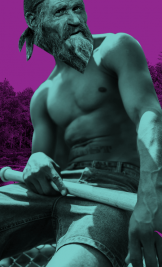

5 animals whose career was more successful than yours
Larry the Cat came to the UK government from the Battersea animal shelter. In 2011, he caught his first mouse, was promoted to Chief Mouser to the Cabinet Office and subsequently worked for five prime ministers. And what have you achieved?
Horse priest
Ancient Rome, 1st century BC
Starting with Julius Caesar, all Roman emperors underwent a deification procedure after their deaths. But even the deified (divus) were not equal to the ancient gods (deus). Caligula was the first to demand all the honors of the gods during his lifetime. There are state documents that call him Jupiter. In some temples, the figures of the gods were beheaded and given the new heads with Caligula’s face.
Unlike an emperor, a god may not respect traditions and superstitions. Caligula made his favourite horse, named Incitatus (‘The Swift One’), a member of the college of priests and, according to legend, was going to appoint him consul. A white marble stable and an ivory manger were built for Incitatus. The horse was decorated with a necklace of pearls and covered with a purple blanket. Caligula enjoyed inviting him to visit, treated him with gilded barley grains and drank to his pet’s health.
The murder of Caligula by the senators in 41 AD prevented them from finding out whether the intention to make Incitatus a consul was just a joke. The fate of the animal is unknown.

Court cat
Japan, 10th century
‘When he crouches, he becomes a ball without feet, resembling a round jade taken from the depths of a cave. My cat moves silently, making not a single sound, like a black dragon about the clouds. I once said to the cat, ‘You possess the forces of yin and yang and have a body that is the way it should be.’ This is how the Japanese Emperor Uda described his black cat in the 9th century.
Due to their geographical location, the Japanese were introduced to cats only in the 5th-7th centuries, when these species were already domesticated all over the planet. The highest-ranking cat in Japanese history lived at the court of Emperor Ichijo (980-1011). Its title of the ‘Chief Lady-in-Waiting of the Inner Palace’ was higher than that of the two best court poets.
It is known that the lady-in-waiting had a red collar with a white clasp. The cat loved to bask in the sunshine on the veranda and play with colourful ribbons.


Dog veteran
United States, 20th century
In 1937, the girlfriend of the bosun of the USСGС Campbell, a US Coast Guard vessel, gave up the puppy of an indeterminate breed. The crew kept him and named him Sinbad. The dog settled down, and was given documents, a uniform and a personal hammock. Sinbad became one of only two dogs in the history of the U.S. military with the status of a service member.
During his 11 years of service in the Coast Guard, Sinbad became a true sea dog – that’s the English term for experienced sailors. The team took him with them to port bars, let him drink whiskey and beer, and did not punish him for getting into fights.
With Campbell, Sinbad survived a ramming by a German submarine and an attack by Luftwaffe planes. The captain believed that the dog guaranteed the ship’s invulnerability. By the end of World War II, he was promoted to Chief Petty Officer, was awarded 6 medal ribbons on his collar, and became nationally known. In 1948, the dog retired and spent the rest of his life at a lighthouse in New Jersey.




Pig candidate for president
United States, 20th century
On August 23, 1968, for the first time in the history of the United States, an animal was nominated as a presidential candidate. The pig named Pigasus was purchased by singer Phil Ochs, a member of the Youth International Party. With its help, the left-wing radicals were going to mock the country’s repressive political system.
Pigasus’ program speech, read by party member Jerry Rubin in front of more than 200 activists, was interrupted by the police. Eight people were arrested for disturbing public order; the presidential candidate was arrested, too.
Pigasus returned to the farm and gained a lot of weight.
Penguin-in-Chief
On August 22, 2016, Sir Niels Olav III was promoted to the rank of brigadier general of the Norwegian King’s Guard. He inspected the troops and made some remarks. The ceremony took place at Edinburgh Zoo, and the general was… a penguin.
The guardsmen first visited the zoo during the 1961 festival of military bands. The Norwegians were especially interested in the colony of king penguins, and in 1972 Lieutenant Nils Egelien convinced the commanders to take patronage over one of them. The penguin was named Niels Olav, after Egelien and King Olav V of Norway. In the rank of corporal, he became the official mascot of the Norwegian King’s Guard.
Since then, each visit of the guardsmen to the zoo has been accompanied by the penguin’s promotion. He was promoted to the rank of sergeant, regimental sergeant and honorary regimental sergeant; became an honourable commander in 2005, and was knighted three years later.










